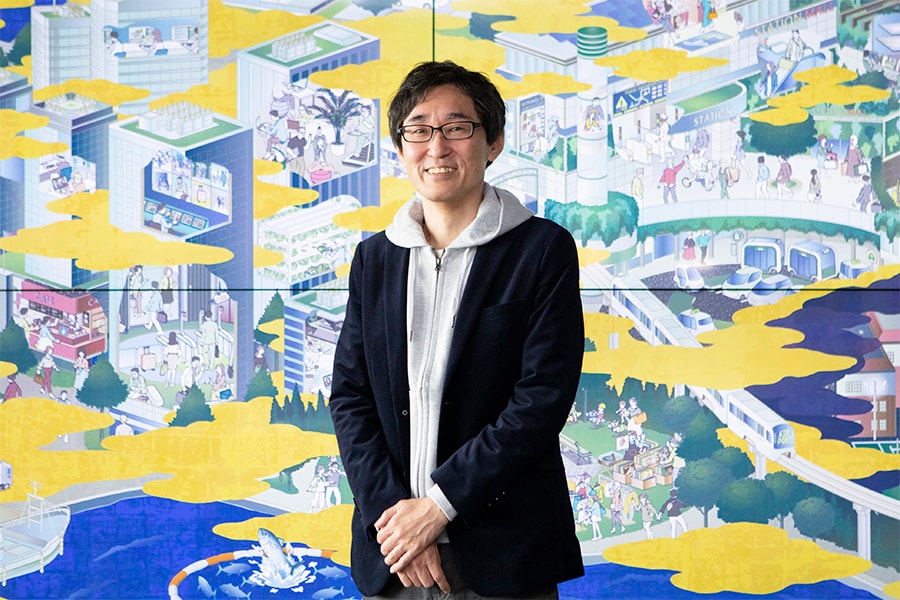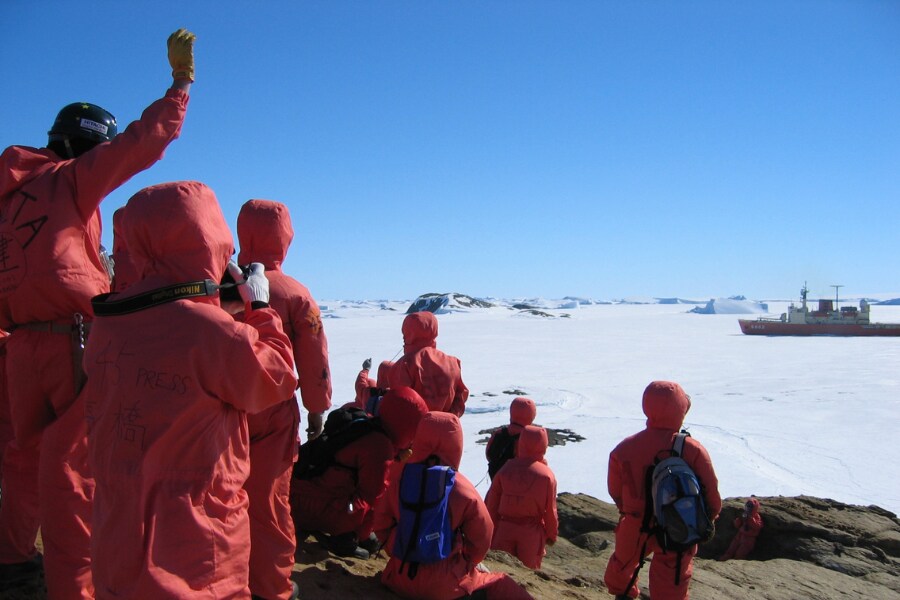The People of Hitachi: "Bringing Change to Society via the World of the Ultra-Microscopic" as the Challenge of a Researcher
Mar. 5, 2025
Minako Tsuchihashi
The kid who used to gaze at the stars in the night sky with a telescope in hand is now using an electron microscope to unravel the mysteries of a world so minuscule that no one has ever seen it before.
At such a small size, this is the atomic level—the smallest unit of matter. And he, as a world first, has succeeded in observing the magnetic field of an atomic plane (lattice plane), a place where atoms are regularly arranged, thus trailblazing a path toward shining light on this unknown world.
"I want to see what cannot be seen." It is with these words that this article deep-dives into the thoughts that motivate Toshiaki Tanigaki, a Hitachi researcher who explores the world of the ultra-microscopic via an electron microscope.

Tackling mysteries via the world's most-advanced electron microscope
Hatoyama Town, Saitama Prefecture, Japan. Located about 60 km from Tokyo Station, the town is surrounded by beautiful greenery, and this is where Toshiaki works as a principal researcher: the Hitachi Research and Development Group's Hatoyama Site.
If one had to sum up Toshiaki's work in one phrase, it would be "making the invisible visible." In using a holography electron microscope at the world's highest level of performance, Toshiaki observes various materials from around the world, such as metals, ceramics, paints, etc., at the atomic level, all so as to understand and elucidate their properties.
In past research, Toshiaki has even observed grains of sandy matter brought back from the asteroid Ryugu by the Asteroid Explorer Hayabusa2.
He comments: "Up to this time, I've observed countless types of materials, substances, and specimens for analysis, but I am always surprised by things such as when 'the atoms in the substance are arranged in a peculiar way' or when things are 'not as I expected.' So, every time I peer through my microscope to observe the world of the ultra-microscopic, I am extremely excited."

In shining light on a sample to be observed, unlike an optical microscope, which uses a lens to magnify the image, electron microscopes use electron waves instead of light. This is what allows the observation to occur.
Toshiaki comments again: "Is it that electron waves pass through the sample or do they collide and refract? Based on the interference of the waves as caused by the sample, the electron microscope can produce a hologram, i.e., a three-dimensional photographic image."
Wishing for a telescope ever since boyhood
Toshiaki spent his childhood in Ikadachitochucho, Otsu City, Shiga Prefecture, Japan. Located on the west shore of Lake Biwa and surrounded by mountainous terrain, the area is truly "nature's toy box." During his days, Toshiaki would spend his play time observing plants and insects and making wooden crafts.
His final "treat of the day" was watching the stars twinkle in the stunning night sky. He says his parents often joined him on this visual adventure.
And, as this is a place where the sky is always clearly visible, the stars always shined beautifully.
However, as Toshiaki got older, certain doubts about what he was seeing started to spring up within him.
He relates: "I began to learn that, from illustrated books, there are craters on the surface of some objects in the sky and that others have rings around them. Yet, they only look like tiny 'dots' to the naked eye, so how can we really be sure that things truly exist as they are described?"
He came to want to see every detail. So, Toshiaki's parents bought him a telescope, and then he could observe the Moon.
He comments further: "I saw a crater featuring a lot of uneven, bumpy areas. Up to this point, this was the moment when I saw something that I had never seen before."
This experience deeply inspired Toshiaki, and it was from this point on when he became completely absorbed in the field of science.
Then, in high school, Toshiaki was in the yacht club but was more interested in how yachts "work" than in how they are made to "work properly." This was the basis of his curiosity. Whenever he was curious about something and how it worked, he would immediately go to a bookstore and read books in search of the answer.
Then, in his third year of university, another turning point came.
He comments: "When I was choosing a lab, I came across a Hitachi electron microscope for the first time ever."
This encouraged him to give electron microscopes a try.
He comments further: "This gave me a clear picture of what the microscopic world actually looks like." This is how Toshiaki describes his first view of nanoparticles projected and shown lined up in a row.
He also says: "When a substance that looks almost like a wispy nothing to the naked eye passes through an electron microscope, it looks completely different. I thought this was utterly fascinating, and from then on, I completely immersed myself in the world of all things microscopic."
Then, it was in 2004 when Toshiaki joined Hitachi.
If confronted with 100 possible solutions, embarking on all 100
Hitachi's research into electron microscopes dates back to 1939.
The year of 1942 saw the manufacturing of the first domestically produced (Japan) commercial microscope, the HU-2. Improvements were continued over the long term, culminating in 2014 with the development of a 1.2 MV ultra-high-voltage holography electron microscope, which boasted the world's highest resolution at the time. Then, in 2017, in collaboration with RIKEN, Hitachi succeeded in observing a magnetic field of 0.67 nanometers using their proprietary electron microscope.
One nanometer equals one billionth of a meter. As such, this is an incredibly small world, occurring in the order of 100,000s the thickness of a human hair. However, there were still challenges to overcome. One of these problems involved "focus error."
Toshiaki relates: "We took nearly 1,000 images with our electron microscope, and then finally we got one in focus. So, we thought that, if we can improve on this performance, we would be able to see worlds that are even smaller."
Thus, in taking the baton that has been passed down since 1939, Toshiaki's challenge began.
He comments further: "If we knew the exact answer to 'how to improve the focus,' we could simply ask an outside engineer to program it for us. However, in terms of asking 'what can we actually do to actually focus,' the answer is that research is progressing while searching for solutions. The only way to solve this is to try each solution, one by one, by ourselves."
So, there it becomes: "If confronted with 100 possible solutions, embark on all of them." Through steady hard work, Hitachi was able to develop a technology that automatically corrects image focus after shooting.

And with that, as a result of this increased precision, and for the first time in the world, Hitachi succeeded in capturing an image of a magnetic field in which atoms are regularly arranged at a distance of 0.47 nanometers.
Toshiaki's achievements have thus been highly praised, and a paper written mainly by him as the central figure was published in Nature, which is an international scientific journal in which researchers from all over the world aim to be published.
For taking the realms of science one step further
Being able to observe the world in which magnetic forces work at the atomic level is of great social significance.
On this, Toshiaki comments: "For example, electric motors use the power of magnets to cause their rotation. To make such a motor rotate faster, a stronger magnet is needed. To understand how to develop a stronger magnet, it is important to observe the material that generates the magnetic force at the atomic level and to then understand the mechanism behind it all."
So, how does a magnetic field change depending on the arrangement of the atoms in the material? And how exactly do atoms and magnetic fields interact with each other? If you know the answers to these questions, you would be able to come to think of improved atomic arrangements and combinations when developing new materials.

Toshiaki's research group is currently engaged in new areas of research. One of these areas involves observing samples inside liquids and gases.
He comments: "Previously, samples could only be observed when set inside a vacuum. However, we thought that, if we could observe actual chemical reactions at the atomic level in a liquid or gas environment, which is similar to the real world, this could lead to the development of new catalysts, which are substances that can aid chemical reactions."
Chemical reactions support society in many ways. For example, electric vehicles (EVs), which have attracted wide attention for being environmentally friendly, get their energy from chemical reactions inside their batteries. Therefore, if it was possible to replace battery materials with something better, it would be possible to make batteries lighter and extend their lifespan. In addition, in using light, water and carbon dioxide, it might be possible to herald the discovery of catalysts that enable what is known as "artificial photosynthesis," which produces chemicals useful for daily life, hydrogen and oxygen, etc., similar to the way in which photosynthesis occurs in plants.

Toshiaki comments further: "Through these achievements, if science could be advanced even just a little, there is nothing that would make me happier."
Against that backdrop, Toshiaki's research steadily continues, with the aim of further shedding light on the world of the ultra-microscopic.
*Some of the developments described in this article were supported by the Funding Program for World-Leading Innovative R&D on Science and Technology (FIRST Program).



